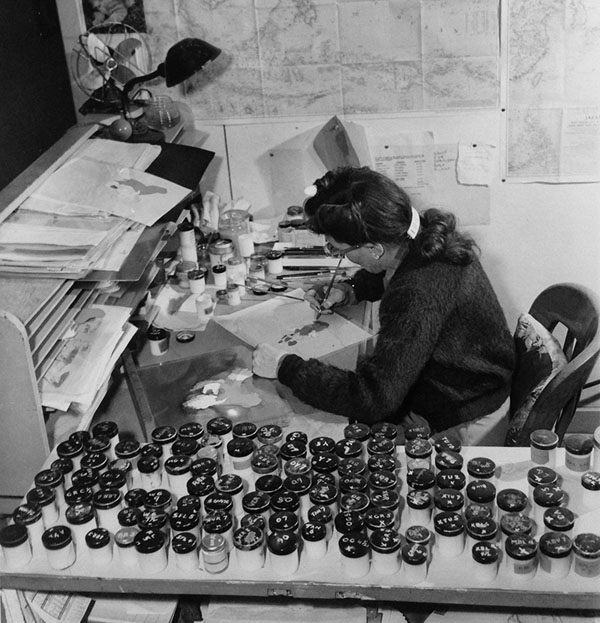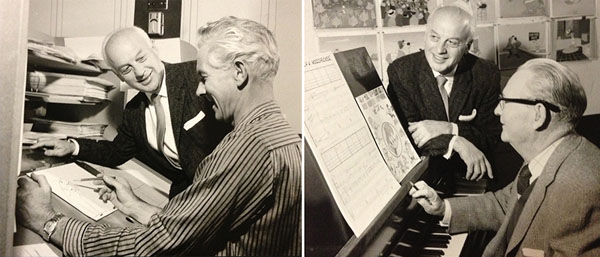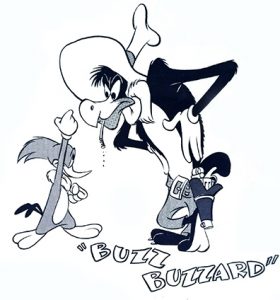
After Walter Lantz took charge of the Cartoon Dept. at Universal Pictures in 1929, his lengthy career affiliation with the studio continued for decades, and in some ways we can look at his achievements as a producer as a story told with four buildings. The first one, as I described in my last post, was something of a Termite Terrace precursor. It had tattered wood floors, a central heater, and lots of makeshift animation desks built by the carpenters who crafted Universal’s classic movie sets. Here’s a tour of Lantz’s four buildings.
 CARTOON DEPT. This was Oswald the Lucky Rabbit’s house, where those post-Winkler cartoons were made. It was a ramshackle structure with the words Cartoon Dept. painted in black over the entrance, as blunt as you might see it in a Mack Sennett comedy. This is where Bill Nolan had been co-producer with Lantz until the financial squeeze had gotten so tight at the studio. As things changed, the Laemmle management was overthrown and Nolan left, too. These were tough times that made Lantz hungry to survive. Manuel Moreno was his stalwart floor commander. Under their guidance, the look and feel of the cartoons kept changing to keep apace with Disney during these worst years of the Depression.
CARTOON DEPT. This was Oswald the Lucky Rabbit’s house, where those post-Winkler cartoons were made. It was a ramshackle structure with the words Cartoon Dept. painted in black over the entrance, as blunt as you might see it in a Mack Sennett comedy. This is where Bill Nolan had been co-producer with Lantz until the financial squeeze had gotten so tight at the studio. As things changed, the Laemmle management was overthrown and Nolan left, too. These were tough times that made Lantz hungry to survive. Manuel Moreno was his stalwart floor commander. Under their guidance, the look and feel of the cartoons kept changing to keep apace with Disney during these worst years of the Depression.
CONSOLIDATED FILM. When the division was reorganized, becoming Walter Lantz Productions in 1936, the building changed, too. Instead of old wood, it was relocated to a modern fortress of concrete, the Consolidated Film Industries building, next to Stage 10 on the Universal lot. It had see-through interior walls made of glass reinforced with metal wire mesh. People could see from one room right into the next. These open views of concrete and glass gave a cold and severe aesthetic to the animation studio.
As Oswald receded in popularity, the Consolidated Film building was the place where Lantz kept casting around for his next potential star. Babyface Mouse, Nellie, Andy Panda, Li’l Eightball, Punchy and even the Nertsery Rhyme series were all contenders. This was also the period where the cartoons had credited directors, including notables brought in to develop these new stars. Despite the turnstile of directing talent, one of the unsung heroes was Ed Kiechle, a steadying force who provided visual development and painted the lush backgrounds that fittingly brought Lantz Productions into the (three-color) Technicolor era.

Inking and painting cels of an Andy Panda cartoon during wartime, with maps of Southeast Asia and Japan on the wall behind.
LANKERSHIM BLVD. As World War II began, Lantz gained financial independence from Universal. He needed to leave the studio lot, but he didn’t go far. He rented a space immediately outside the grounds of Universal, built into the perimeter wall, sandwiched just between the studio boundary and Lankershim Blvd. It was this location—a white single-story building with “Walter Lantz Cartunes” in big letters out front—that witnessed the Golden Age of Woody Woodpecker under directors Alex Lovy, Shamus Culhane and Dick Lundy, with some outstanding design work by Art Heinemann and Emery Hawkins. This was also the site of wartime film production, meaning that part of the studio could only be accessed via security clearance.
 Walter Lantz was desperate to turn the tide against disheartening trends, doing his part in the war effort. The zeitgeist of this era, despite sunny California being spared from any direct conflict, manifested in Woody as a brazen aggressor who found his way with mayhem and forthrightness. The national euphoria of defeating the Axis powers did not translate into a sudden change in his fortunes, though. Lantz stayed at the Lankershim facility with a pared down staff. Over the next few years, he stayed lean and mean to remain in business, but at least he had finally groomed an undeniable star in Woody Woodpecker.
Walter Lantz was desperate to turn the tide against disheartening trends, doing his part in the war effort. The zeitgeist of this era, despite sunny California being spared from any direct conflict, manifested in Woody as a brazen aggressor who found his way with mayhem and forthrightness. The national euphoria of defeating the Axis powers did not translate into a sudden change in his fortunes, though. Lantz stayed at the Lankershim facility with a pared down staff. Over the next few years, he stayed lean and mean to remain in business, but at least he had finally groomed an undeniable star in Woody Woodpecker.
861 SEWARD ST. When his contracts with Universal continued to grow untenable, Lantz signed for a year to have his cartoons distributed by United Artists instead. This also coincided with the phenomenon of “The Woody Woodpecker Song,” which became a pop craze in 1948. Universal was dismayed to see they had let Woody switch teams to join UA, so they suddenly tried to make good. By that point, Lantz no longed worked along the outer wall of Universal. He had set up shop on 861 Seward Street in Hollywood.
So began Walter’s period of great prosperity as a producer. His new contract with Universal was favorable and he began to secure more and more licensing deals with Woody and friends. As he turned fifty, the hair that remained on his head was turning white and he was a snappy dresser in a crisp suit and tie. He was all about business, leaving most of the details of the cartoons to his stable of directors. The best director of Woody in the Fifties was Don Patterson, who very capably kept the series moving along without losing too much of the character’s brash appeal, though that effort was lost by the middle of the decade. Patterson stopped directing to be an animator again, and with that move Woody seemed to have lost his edge.
Lantz brought back some of the animators who had been with him in the early days at Universal. Paul J. Smith went on to direct for over twenty years, an unfortunate choice. Tex Avery and Alex Lovy both had stints returning to direct at Seward Street, and Avery—within a very brief time—managed to turn Chilly Willy into a rising star, whereupon Lovy maintained the penguin’s gag formula in a continuation of the series that gave rise to Lantz’s second most popular all-time character.

Walter Lantz in a 1957 promotional photo with Don Patterson (left) and with studio composer Clarence Wheeler (right) working on the score for To Catch a Woodpecker.
INFINITY AND BEYOND? Don Patterson provided Woody with a strong foil in the character of Buzz Buzzard, an ill-tempered villain and con artist whom Woody could direct his ire at, getting into scraps with aplomb. Buzz had already debuted in the UA cartoons during the late Forties, but then appeared with regularity under Patterson. Lionel Stander originated the voice, continued by Dal McKennon, and was then played by Mark Hamill in the 1999 FoxKids TV reboot.
 My favorite cartoon starring Buzz is Wild and Woody, set in a lawless Western town where Woody becomes the new sheriff and needs to confront the sheriff-shootin’ outlaw. As an early example of the popular Woody and Buzz duo, this one is distinguished for featuring a Sheriff Woody quite a few ‘lightyears’ before Toy Story had done the same, right down to having his rival named Buzz.
My favorite cartoon starring Buzz is Wild and Woody, set in a lawless Western town where Woody becomes the new sheriff and needs to confront the sheriff-shootin’ outlaw. As an early example of the popular Woody and Buzz duo, this one is distinguished for featuring a Sheriff Woody quite a few ‘lightyears’ before Toy Story had done the same, right down to having his rival named Buzz.
I have always smiled a little wondering if Pixar had offered a wink in homage to the original duo, though there has never been any reason to think this was intentional. Could it have been unintentional? Was it like the idea planted in the movie Inception? Lightyears later, could it just have been that while developing two rival characters at Pixar, the names Woody and Buzz just seemed to subliminally go well together? I realize Buzz Aldrin is a likelier inspiration for conjuring a space ranger’s name, but regardless we can enjoy this animated coincidence.
BABY BOOMERS. The generation born in those post-War years spent plenty of hours watching cartoons on televisions that quickly became a feature of every American living room. That was how Walter Lantz ultimately achieved his greatest wealth as a businessman, leveraging the value of his film catalogue within packaged episodes in TV syndication. Baby Boom kids were steeped in The Woody Woodpecker Show. They had seen Woody sparring with Buzz many times over.
For Lantz, that was a gratifying part of his career. He could finally relax and enjoy his success. Who could argue that he hadn’t earned it? He liked being on camera and eventually he was also the friendly face of his television franchise, appearing in filmed interstitials for the show. He loved seeing the delight of children entertained and he enjoyed making media appearances and reading and responding to his fan mail from kids. It was at his Seward Street studio where he presided over his enterprise until 1972, when he became the very last producer of theatrical short cartoons to close shop, quite literally turning out the lights on an era.
Photographs courtesy of UCLA Library Special Collections, from the Walter Lantz Collection. Photo of Bill Nolan in front of Universal’s Cartoon Dept. courtesy of Michael Barrier.
For more information on the cartoon WILD AND WOODY – Click here


 Tom Klein is a Professor and the Chair of the Animation program at Loyola Marymount University, in Los Angeles. He has been published internationally and has been profiled in The New York Times for his work as a scholar of the Walter Lantz studio. He has worked at Vivendi-Universal Games and Universal Cartoon Studios. Follow him @VizLogic
Tom Klein is a Professor and the Chair of the Animation program at Loyola Marymount University, in Los Angeles. He has been published internationally and has been profiled in The New York Times for his work as a scholar of the Walter Lantz studio. He has worked at Vivendi-Universal Games and Universal Cartoon Studios. Follow him @VizLogic



















































It’s a shame “Wild and Woody” didn’t get nominated for an “Academy Award” as the studio hoped. This really was a very fine cartoon or “cartune”.
The really unfortunate part was that — just as Friz Freleng and Michael Maltese created Yosemite Sam to be a stronger opponent for Bugs than Elmer Fudd had been — Buzz was the kind of opponent Woody could go all-out against due to Buzz’s meanness, as opposed to Woody’s battles with the perpetually befuddled Wally Walrus, where you kind of felt sorry for Wally due to the abuse he was getting.
Lantz finally had a strong recurring character for Woody to battle, but only got to use him in three cartoons with full, higher-budgeted animation, before the UA shutdown and reopening at Universal under the lower budgets (Buzz was still a good opponent in the early 50s, but nowhere near as expressive as in Lundy’s last three woodpecker cartoons).
Tom, check out these cool Walter Lantz letters to the Kelloggs folks:
http://www.ebay.com/itm/WOODY-WOODPECKER-1966-Walter-Lantz-Studio-merchandising-info-Kelloggs-cereal-box-/232297044669?hash=item3615fb9abd:g:C94AAOSwmgJY6Vzq
Thanks for sharing that, Pat. As this sale item shows, Kelloggs Cereal sponsored the WW Show and was a huge source of income for WL Productions. And, as our generation well remembers, eating cereal in front of the Saturday morning cartoons was a treasured part of childhood!
The photo of Walter above, holding film cans, is in front of 861 Seward Street in 1957. Within the Walter Lantz Collection at UCLA, there is not a single photo of the exterior of the classic Lankershim ‘Cartune’ studio. The only photo I have seen of it is held by the indispensable Michael Barrier, cartoon historian extraordinaire, available to see within his essay and interview with Roger Armstrong, “Life at Lantz, 1944-45,” on his website:
http://www.michaelbarrier.com/Essays/Armstrong/Armstrong.html
This photo is attributed to Dick Lundy, the director of Wild and Woody. And it’s useful to look at to understand my description above of how the building was actually connected to the outer studio wall of Universal, with a front door that opened right on to sidewalk of Lankershim.
Speaking of Armstrong, I reminded of this gag drawing I picked up from eBay many years back I shared with Michael Barrier he gladly put on his site. Not a great scan (the scanner I was using was on its last leg) but I did my best to get it all in, but I love it!
http://www.michaelbarrier.com/Essays/Armstrong/ArmstrongBySolomon.jpg
Sheriff Woody / Buzz > Toy Story… why didn’t I ever make that connection?
I was one of those boomers who was glued to the tube while grandfatherly Lantz described how cartoons were made. I had every intention of being an animator at age 7-8. My destination was Warner, but my mentor was Walter Lantz.
I do wish psychotic 1940s Woody had endured longer.
That Andy Panda cel looks a little like a scene from Andy Panda’s Victory Garden (1943).
Ok, just to have some fun with this, and largely because there’s already a thriving cottage industry of ‘cartoon conspiracy’ theories about Pixar films, here’s two more links to the 1948 Lantz classic. In WILD AND WOODY, in the saloon scene, Woody turns into a rocket and blasts up into the sky, creating a momentary Old West/Space Age genre mash-up. Hmm, interesting. Then, let’s not forget that Woody first appeared in a cameo within an Andy Panda cartoon, thereby owing him a debt of gratitude. And in TOY STORY, whose name is written under Woody’s boot? That’s right: ANDY!
Andy is the name of the kid who owns the toys (including Woody and Buzz). So all three members of the “triangle” have the names of Lantz characters!
Welcome Tom.
From what I understand, the budgets for the UA releases were not any higher than those of Universal’s. Perhaps Tom can be more specific?
Oh yes, watching the Kelloggs sponsored WOODY WOODPECKER SHOW is one of my most fondest and vivid childhood memories. Just loved Woody. Even got one of those Woody cups and cereal bowls by sending in a box top and I think 50 cents. Still have it.
To clarify, I meant “was a huge source of income” for WLP later via the tv show. The brief period of UA cartoons, as you mention, was marked by similar (fairly low) budgets in the late 40s. Although Lantz gave no reprieve from his frugal approach for the UA series, some gifts landed his way, including the services of legendary Fred Moore, getting him for cheap when he was ‘exiled’ from Disney. And I meant to thank you, Pat, for your suggestion a few weeks back that I write a book. I welcomed the remark, especially because one of my intents with all these Lantz studio columns has been to test out some of my research to inform my larger goal of doing exactly what you say: write a definitive book. You’ve been offering comments and support since my very first column and I’ve been really grateful for that.
Hi Tom,
Thanks for this post. The old 861 Seward building has seen a lot of cartoon history! I believe that the building (which is still there), was a Harman and Ising studio for awhile, and was also the Bambi unit’s location during the development phase of the picture. I used to pick up animation from Milt Schaeffer, who directed commercials for the Levitow-Hansen shop, which was in the upstairs part of 861 Seward. That was just a little after Lantz stopped making theatricals. I tried to get a job several times at the Lantz studio, and they just told me, “You’re going to have to wait until these guys DIE before we’d ever hire YOU!”
The Lantz building is at the corner of Seward and Willoughby Streets…
…thus “Inspector Seward Willoughby”.
Has anyone bothered to ask Lasseter if this is a coincidence or not?